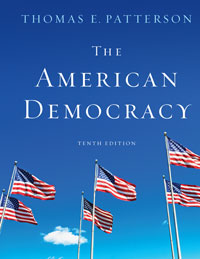 
The American Democracy, 10th Edition (Patterson)Chapter 18:
State and Local Politics: Maintaining Our DifferencesChapter Overview
This chapter examines the American states and the localities within them. The author summarizes the general patterns that characterize state and local governments, and concludes with a comparison of the states that illustrates major factors behind differences in their politics and policies. The main points of the discussion are as follows:
- All states apply the constitutional principle of separation of powers, but the states otherwise differ from one another—and from the federal government—in the way in which they structure their governments. The use of elections as a means of choosing officials of all types, including judges and lesser executives (for example, state treasurer), is widespread.
- Local governments are not sovereign; they are chartered by their state government, which determines the limits of their power. Of the units of local government (county, municipality, township, school district, and special district), the basic unit is the municipality. A municipality may be governed in one of four ways—the strong mayor-council, weak mayor-council, commission, or city manager system.
- States and localities have primary responsibility for most of the policies, such as public education, that directly touch Americans’ daily lives. The nature of these policies is affected by the wealth of the state or locality and also by its political culture, party system, and group system.
 |  |
|

















